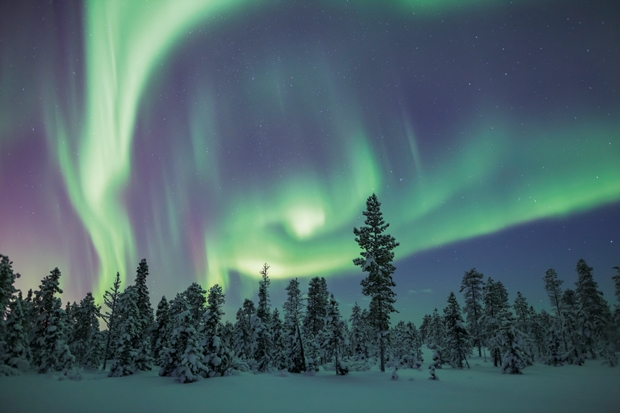Getting here took a long time. First a flight to Seattle, then a connection to Fairbanks, followed by a coach to Coldfoot Camp and a final stage by minibus. It’s long after midnight and I’m shivering outside a snow-covered lodge in Wiseman, Alaska (population: 14), two hours north of the Arctic Circle, wrenching my tripod so the camera points straight upwards and trying like a fool to capture what essentially cannot be captured. I’m looking at the Northern Lights.
The aurora borealis, the result of electrically charged particles causing havoc in the upper atmosphere, is the reason I’m here in America’s biggest state. For months I’ve been consulting the University of Alaska’s Geophysical Institute space weather forecast website, becoming a temporary expert on exciting things like X-ray flux and the Carrington rotation. The tour company runs nightly viewing excursions to this lodge, in which visitors like me can sit in comfort drinking hot chocolate while a guy in US military snow gear stands outside scanning the skies like a UFO nut.
Tonight is average: a few splashes of green separated by 20-minute interludes of Arctic night, and then it’s back to camp on the minibus. Having come all this way, I vow to pay another $60 and come back again tomorrow. This turns out to be the right decision. For a couple of hours, on and off, we are treated to quite a display, which the Alaskan lodge-keeper tells us is one of the best he’s witnessed this season. I doze happily all the way back from this second outing, satisfied that I got what I came for, and look forward to 12 hours’ sleep the following night.
Tucked up in bed almost 24 hours later, I find myself awake at 2 a.m. and think, what the hell, I’ll poke my head outside and see if anything’s happening. And lo, aliens have invaded. All across the sky are fissures and spirals in pink, purple and yellow. At minus 30 degrees you can be covered in snow and not get wet, because the white stuff never thaws enough to soak through your outer layer of clothes, so I give up on taking photos, live in the moment and lie on my back in the snow watching the laser show directly overhead.
Since it is only to be seen at these latitudes, most of us experience the aurora only through photographs. There are two problems with this: first, a still image can’t convey the sheer kinetic energy of the lights, which are never still, warping and swirling for as long as they’re visible. Second, digital camera sensors are really only sensitive to the green hues, meaning even the best photo reproduces only a fraction of the range of colours. So whenever you see a photo of the aurora borealis that takes your breath away, be aware that the reality was even more breathtaking. You really do have to see it for yourself.
Which is why, as you read this, I’m in the far north of Finland trying again. Keep your gloved fingers crossed for me.






Comments